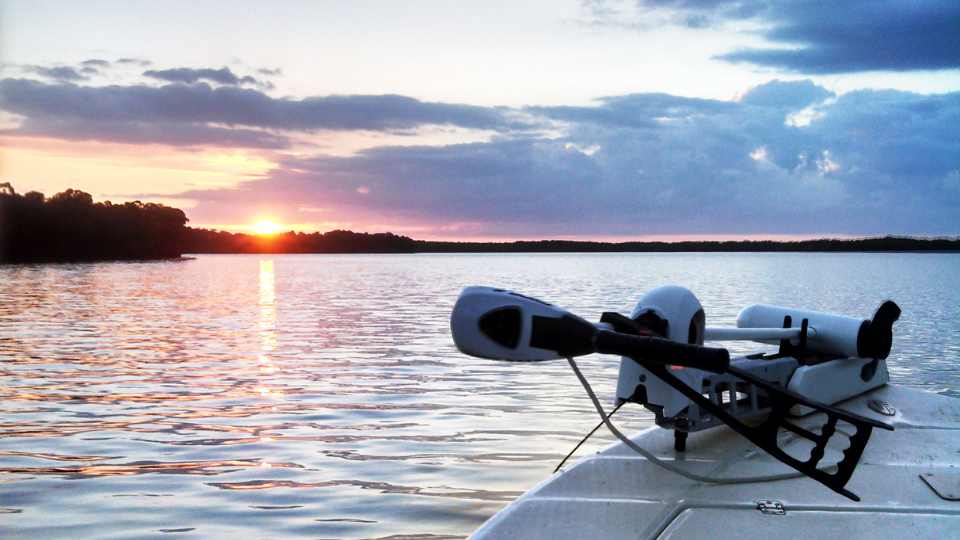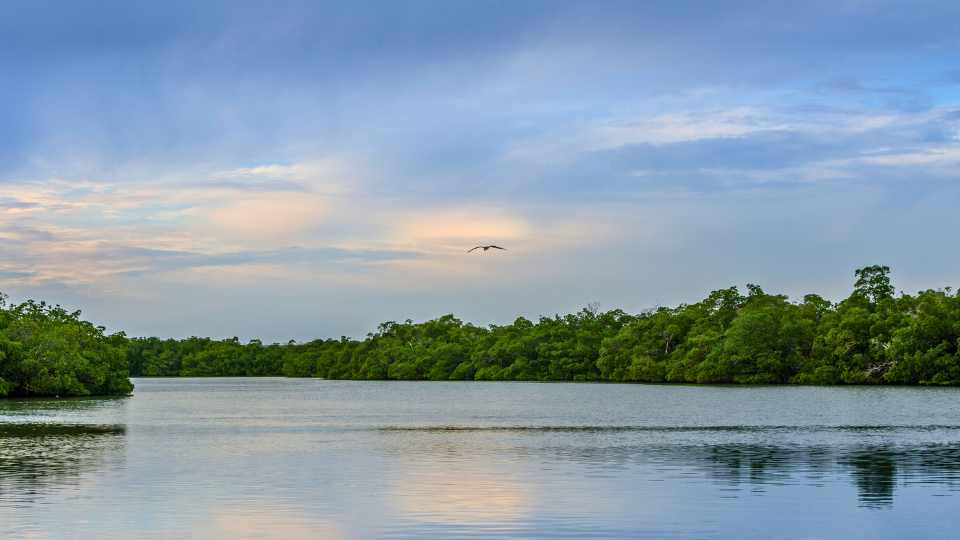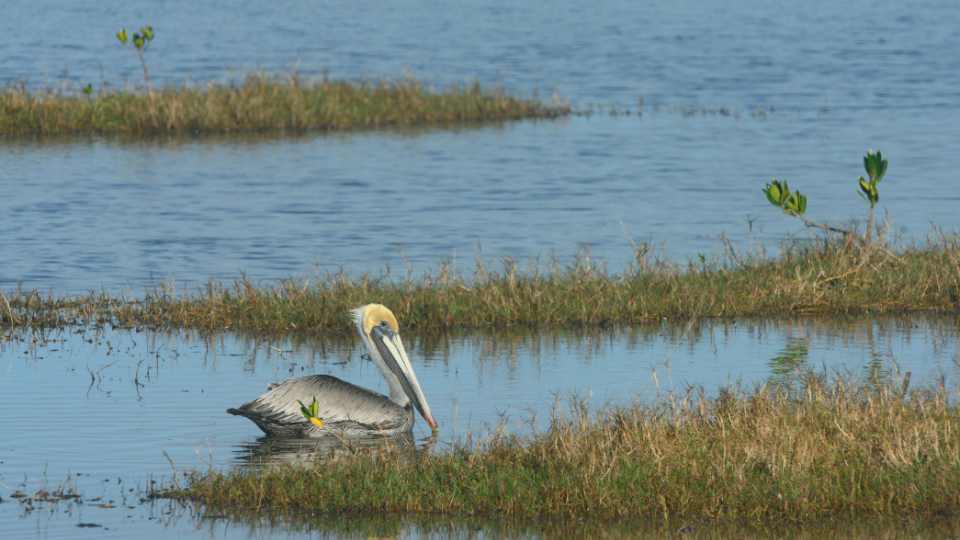
Nestled on the southwest coast of Florida lies the Ten Thousand Islands, a picturesque archipelago where the Gulf of Mexico’s turquoise waters meet the lush mangrove forests. This unique region stretches from the southern tip of Marco Island to the outskirts of Everglades City, forming part of the Ten Thousand Islands National Wildlife Refuge. The islands, ranging from mere specks of land to larger plots, provide a haven for a diverse array of wildlife and are a crucial breeding ground for countless marine species.
For outdoor enthusiasts and nature lovers, the Ten Thousand Islands offer an exceptional experience away from the hustle and bustle of city life. Visitors can enjoy a multitude of activities such as fishing, boating, and shelling. With abundant opportunities to explore this rich ecosystem, careful navigation through the labyrinth of waterways and mangroves is essential, as the shallow waters can be tricky to traverse.
The Ten Thousand Islands are not only significant for their ecological value but also provide an alternative to the typical Florida beach destination. Whether through a guided boat tour, which simplifies navigation and offers insightful commentary, or by renting a vessel for a personal adventure, this wetland wonderland invites exploration of its serene waterways, remote islands, and the engrossing stories of its natural environment.
Geographical Overview
The Ten Thousand Islands represent a remarkable geographic area of the United States, located off the Gulf Coast of Southwest Florida. This section offers a detailed examination of its location and relationship to significant bodies of water, such as the Gulf of Mexico.
Location and Geography
Ten Thousand Islands is an archipelago that stretches from the southern end of Marco Island to the vicinity of the Lostman’s River. Notably, the islands are part of Collier County, Florida. Contrary to their name, they consist of hundreds of islands and islets, rather than literal thousands. These landforms have been shaped by the hydrology and ecology of Florida’s coast:
- Mangrove Islands: The dominant vegetation.
- Brackish Ponds: Mixed freshwater and saltwater environments.
- Marshlands: Freshwater and saltwater variants.
Geographically, the area is a mix of high spots on a historically submerged coastline, creating a unique blend of terrestrial and marine ecosystems.
Gulf Coast and Gulf of Mexico
The islands dot the edge of Florida’s Gulf Coast, leaning into the Gulf of Mexico—a vast body of water critical to the climate, ecology, and economy of the region.
- Coordinates: Approximately 25.85°N, 81.5°W
- Proximity to the Gulf: Immediate; forming a natural protective barrier.
Its waters are fertile, supporting a diverse array of sportfish and wildlife. The Gulf Coast is recognized for its significance to marine life and provides a critical habitat facilitated by the interplay between the Ten Thousand Islands and the Gulf. The islands serve as an integral part of the Gulf’s ecological balance.

Ecology and Environment
The Ten Thousand Islands region in Florida showcases a diverse ecology, supporting a wide range of wildlife within its unique marine and mangrove forest ecosystems.
Mangrove Forests
The mangrove forests of Ten Thousand Islands are crucial to the ecological integrity of the area, serving as nurseries for numerous marine species. The mangroves—consisting primarily of red, black, and white mangroves—form dense and intertwined root systems that provide shelter and breeding grounds for fish, birds, and other wildlife. These forests also act as natural barriers, protecting the coastline from erosion and storm surges.
Marine Ecosystem
The marine ecosystem of the Ten Thousand Islands is intricately linked to the health of the mangrove forests. Beyond the mangroves, the seagrass beds and coral reefs support a diverse array of marine species, including fish, sea turtles, and dolphins. This area, part of the Everglades National Park, plays a pivotal role in the life cycles of various endangered species. The waters and islets provide habitats and migratory stopovers for countless wildlife, emphasizing the importance of ongoing conservation efforts to sustain these fragile ecosystems.
Recreational Activities
The Ten Thousand Islands offer a diverse range of water-based and land-based recreational activities suited to all ages and preferences, from tranquil fishing to adventurous kayaking through complex waterways.
Boating and Fishing
Boating is a popular activity in the Ten Thousand Islands, with ample opportunities for fishing enthusiasts. Anglers can find a variety of fish species in the surrounding waters, including snook, redfish, and tarpon. Various companies offer boat rentals and guided tours, allowing visitors to navigate the unique ecosystem.
- Boat Types Available for Rent:
- Skiffs
- Pontoon boats
- Center console boats
- Fishing Tours May Include:
- Experienced guides
- Fishing gear and tackle
- Knowledge of local hotspots
Kayaking and Canoeing
Kayaking and canoeing are ideal ways to explore the labyrinthine mangrove tunnels and shallow waters of the Ten Thousand Islands. Paddlers may enjoy the close encounters with wildlife and the tranquil atmosphere. Rentals and guided paddling excursions are available, giving visitors both independence and educational experiences.
- Canoe/Kayak Rental Options:
- Single kayaks
- Tandem kayaks
- Canoes
- Paddling Tours Might Offer:
- Map and safety gear
- Paddling instructions
- Eco-tour guides
Camping and Picnicking
For those seeking an immersive experience, camping is permitted in designated areas within the Ten Thousand Islands, providing a unique opportunity to overnight in this pristine natural setting. Picnic areas are also available for day visitors to enjoy a meal amidst the beauty of the islands.
- Camping Spots:
- Beachfront sites
- Backcountry sites (permit required)
- Picnicking Essentials:
- Picnic tables and grills
- Trash disposal facilities
- Scenic views

Wildlife and Conservation
Ten Thousand Islands, located in Southwest Florida, serves as a vital habitat for a wide array of wildlife, with concerted efforts in conservation to ensure the survival and health of these species. The region is particularly important for both resident and migratory bird species, as well as a number of threatened marine animals.
National Wildlife Refuges
The Ten Thousand Islands National Wildlife Refuge was established with the goal of protecting the delicate estuarine ecosystems and the various forms of life it supports. Spanning an area of approximately 35,000 acres, the refuge represents a major commitment to conserving wildlife habitats.
- Managed Habitats: Mangrove forests, marshes, and marine areas.
- Conservation Goals: Protecting endangered species, maintaining biodiversity, providing a safe haven for migratory birds, and facilitating research and education.
Native Species
Ten Thousand Islands is home to a rich diversity of resident and migratory wildlife. Some of the notable species that can be found within the national wildlife refuge include:
- Marine Mammals: Florida manatees and bottlenose dolphins are commonly sighted, using the estuarine waters as feeding and breeding grounds.
- Reptiles: Alligators are an iconic species of the region, thriving in freshwater marshes and mangrove swamps.
- Bird Species: This area is a haven for birdwatchers, with sightings of osprey, various wading birds, and bald eagles.
Conservation efforts within the Ten Thousand Islands National Wildlife Refuge are critical for protecting these species and ensuring that the region remains a sanctuary for the diverse wildlife that calls it home.
Visitor Information
This section provides essential details for visitors planning a trip to the Ten Thousand Islands, focusing on how to access the area, navigate through the islands, and information on visitor centers and available facilities.
Access and Navigation
Ten Thousand Islands can be accessed through various entry points including Everglades City, Marco Island, and Chokoloskee Island. The region is renowned for its complex system of mangroves and waterways, which can be challenging to navigate.
- Everglades City: Visitors often begin their journey here, taking advantage of the boat tours from the Gulf Coast Visitor Center.
- Marco Island: Located to the north, it offers additional access points with guided tours and rental services.
- Chokoloskee Island: Lies to the south of Everglades City and provides an alternative entry point.
Boat Tours: A popular way to explore, with guides helping visitors safely navigate the labyrinth of islands and mangroves.
Navigation Tips:
- GPS and nautical charts are highly recommended.
- Gulf Coast Visitor Center offers maps and advice for explorers.
- Permits are not typically required for casual exploration, but visitors should check for the latest rules.
Visitor Centers and Facilities
Visitors can obtain information, maps, and permits from local visitor centers, vital for a planned and safe experience.
- Everglades City: Houses the Gulf Coast Visitor Center, gateway to the Ten Thousand Islands with exhibits, educational materials, and updated information on park conditions.
- Naples: Though not directly in the Ten Thousand Islands, it serves as a nearby hub with several facilities and resources for visitors.
Facilities Include:
- Restrooms
- Information desks
- Boat ramps and docking areas
- Tour operator concessions
- Emergency services
For an updated list of services and hours of operation, visitors should contact the centers directly or visit the official National Park Service website.

Planning Your Visit
When visiting Ten Thousand Islands in Florida, travelers should consider the seasonal weather patterns and available accommodations to enhance their experience.
Best Times to Visit
The optimal period for a visit is during the winter months, from December through April, when the weather is cooler and more suitable for outdoor activities. The area is known for its subtropical climate, meaning summers tend to be hot and humid with frequent afternoon thunderstorms.
- Winter: Cool and dry, ideal for wildlife viewing and boating.
- Summer: Hot and wet; prepare for heat and potential for heavy rainfall.
Tides also play a significant role in planning activities such as boating or fishing in the islands, and visitors should consult tidal charts to make the most of their trip.
Accommodations and Amenities
Accommodations in the area range from hotels to more immersive options like the Ivey House in Everglades City. The Ivey House offers eco-friendly lodging and direct access to water-based tours.
- Everglades City: Closest access to Gulf Coast entrance, with options like the Ivey House.
- Goodland: A smaller, laid-back community with local accommodations, often used as a starting point for exploring the islands.
Visitors should book accommodations well in advance, especially during the high demand of the winter months. Facilities and amenities vary by location, so travelers should research and choose based on their comfort and adventure levels.
